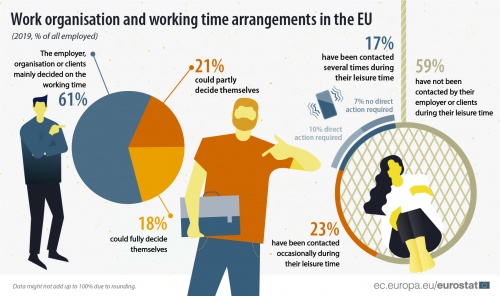Flexibility at work - statistics
Data extracted in September 2020
No update foreseen since data are based on an ad-hoc module.
Highlights
In 2019, the EU-27 population consisted of more than 370 million persons aged 15 years and older. Almost 200 million persons were employed. However, the working time arrangements and the degree of flexibility at work differ greatly across countries and appear to be dependent on several background features including country, sex, age, educational attainment level, professional status, economic activity and occupation. Moreover, it is also affected by the household composition, the size of the firm where persons are employed and the frequency of working at home.
This article is the first of a set of articles related to the topic "work organisation and working time arrangements" (ad hoc module of the Labour Force Survey conducted in 2019). It presents results for the European Union as a whole, for each of the 27 EU Member States as well as the United Kingdom, three EFTA countries (Iceland, Norway and Switzerland) and Turkey (one of the candidate countries).
In the present article, the focus is put on: (1) the degree to which employed people can decide on their working time (start and end), (2) the possibility for them to take, at short notice, a few hours off or one or two days of leave, (3) the degree to which they have to adapt their working time to fulfill work-related tasks and (4) their required availability during leisure time.
Full article
Employers and clients mainly decide on working time in Europe
For the majority of the employed persons in the EU-27, the decision on working time was taken by their employer, organisation or clients in 2019. Indeed, for 60.8 % of the persons in employment, the employer, organisation or clients determined the start and the end of working time in the main job. By contrast, 18.1 % of people could fully decide themselves against 21.2 % of people who partly decided themselves. Almost 80 % of workers in Bulgaria (79.8 %), Lithuania (78.9 %) and Hungary (78.5 %) had the least influence on their working time compared with around 30 % of employed persons in Sweden (34.7 %) and Finland (29.9 %). In addition, almost one in two Swedish (46.2 %) and Finnish (47.6 %) employed persons decided on their own their working time with certain restrictions, while not even one in ten workers in Lithuania (9.7 %) and Bulgaria (9.6 %) had similar possibilities. Moreover, Cyprus shows the smallest share of employed persons who could fully decide on their working time (8.7 %) while Romania and Belgium display the biggest share (both 22.6 %).
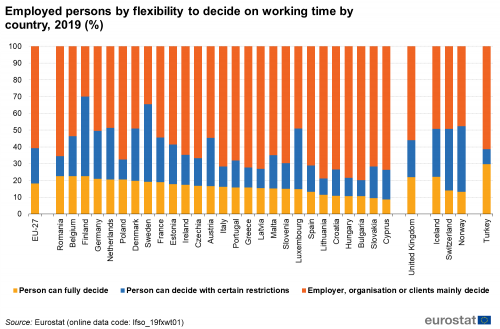
Men, seniors, self-employed and people with a high educational attainment level have more flexibility on deciding their working time
In 2019, the employer, organisation or clients decided more often on the working time of women than men: 63.9 % versus 58.1 %. Fewer women (15.0 %) than men (20.7 %) reported that they could fully decide on their working time. Regarding age, it appears that the younger the person, the higher the chances that the employer, organisation or clients will decide on their working time. Senior workers (aged 50-74) reported less often having employers or clients deciding on their working time than young workers (aged 15-34) and middle-aged workers (35-49 years old): 56.2 % versus 66.9 % and 60.1 % respectively. By contrast, 22.8 % of senior employed persons against 12.7 % of junior workers and 18.0 % of middle-aged workers decided on their working time.
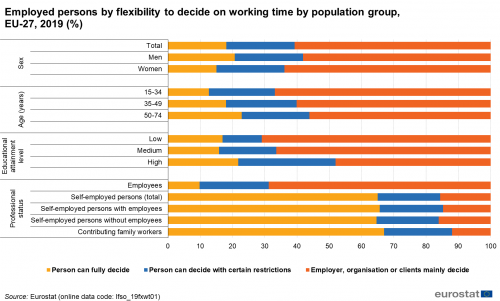
Employed persons with a low educational attainment level were mostly dependent on their employer, organisation or clients regarding their working time: 70.9 % versus 66.4 % of those who attained a medium education level and 48.0 % of those who obtained a high education level. Sex, age and professional status do not seem to affect people who partly decided on the start and end of their working time, as no differences between groups exist. However, educational attainment level has an impact: the higher the education level, the higher the chances people can decide by themselves on their working time albeit with certain restrictions. In 2019, almost one in three persons in the EU-27 with a high educational attainment level was part of this group (30.1 %), compared with 12.2 % of those with a low educational attainment level and 17.8 % with a medium level.
Employees and self-employed differ greatly in the level of decision on working time. Around two in three self-employed persons could fully decide on their working time (65.0 %), while the employer or organisation decided on the working time for 68.8 % of employees. Only 9.8 % of employees fully and 21.4 % partly decided on their working time.
Majority of people with a job in agriculture, forestry and fishing activities fully decide on their working time
More than half of employed persons in agriculture, forestry and fishing activities could fully decide on their working time: 56.7 % versus 14.9 % for their counterparts who could partly decide and 28.4 % for whom the employer, organisation or clients decided on working time. Moreover, for those working in industry (except construction) (69.4 %), in wholesale/retail trade, transport accommodation and food service activities (67.5 %) and public administration, defense, education, human health and social work activities (67.4 %), the employer, organisation or clients mainly decided on working time.
Focusing on occupation, workers in skilled agricultural, forestry and fishery activities are at the top of the list of people fully deciding on their working time with 64.6 %, followed by managers with 43.8 %.

European workers with high degree of flexibility in taking few hours off or couple of days of leave at short notice
Although employed persons in the majority of countries mentioned in 2019 that their employer, organisation or clients decided on their working time, it was very easy for 33.7 % of EU workers and fairly easy for 32.7 % to take one or two hours off at short notice (i.e. within one working day) for personal or family matters in the main job. By contrast, 13.1 % of EU workers said that it was very difficult and 20.5 % said it was fairly difficult (Figure 4A). At country level, Sweden reported the highest share of people for whom it was very easy to take a few hours off (52.2 %) and Bulgaria the lowest share (13.7 %).
Please note that, in the survey, it was assumed that those who mentioned that they could fully decide on their working time also had the freedom to take hours off at short notice (i.e. values were imputed). By contrast, workers who reported that they could only partly decide on their working time or that their working time was decided by the employer, organisation or clients, were explicitly asked the question on the flexibility to take a few hours off.

Similar to the results discussed above, it was very to fairly easy for the majority of EU-27 employed persons to take one or two days of leave at short notice, i.e. within three working days: 35.8 % for fairly easy and 19.0 % for very easy (Figure 4B). On the other hand, 29.1 % found it fairly difficult, and 16.2 % very difficult. For 48.1 % of the persons employed in Slovenia and 41.4 % in Malta, it is very easy to take a few days of leave at short notice, in comparison with only 8.1 % in Bulgaria and 8.7 % in Slovakia. Please note that no imputation was performed for this variable, i.e. all employed persons received the question related to freedom on taking leave.
Self-employed persons more flexible than employees in taking hours or days off
As regards the socio-economic characteristics of those reporting in 2019 that it was very easy to take one or two hours off at short notice, the male population was predominant, with 36.9 % of men versus 30.0 % of women saying that this was very easy. Seniors (38.7 %) also mentioned more often than young (28.0 %) and middle-age (33.7 %) workers to be able to take very easily one or two hours off at short notice. In addition, two in five people with a high educational attainment level (40.0 %) said that it was very easy to take one or two hours off at short notice, followed by 31.9 % and 29.6 % of people with a low or medium educational attainment level.

Similar patterns are found for those who mentioned that it was very to fairly easy to take a couple of days of leave at short notice, although shares for those who said it was very easy are somewhat lower than the results described above. Again, men said more often than women that it was very easy to take a few days off: 20.5 % compared with 17.3 % (Figure 5B). The same holds for the age groups: people aged 50-74 correspond to higher share (22.0 %) than those aged 15-34 (16.3 %) and 35-49 years (18.4 %). Differences by educational attainment level are less clear: while 20.6 % of persons with a high educational attainment level said it was very easy to take a few days off, 17.7 % of those with a medium educational attainment level and 19.2 % with a low level said the same.
For both the hours and days off, self-employed persons had more freedom to take them at short notice than employees. For 73.4 % of self-employed persons it was indeed very easy to take several hours off versus 26.6 % of employees. Contributing family workers reported more flexibility, with 77.8 % of them mentioning very easily taking several hours off at short notice. A similar pattern is visible for the days off, albeit the corresponding shares are much lower: for 37.5 % of self-employed persons it was very easy to take a few days of leave while this was the case for only 15.6 % of employees. By contrast, taking days off was fairly easy for 29.8 % of self-employed persons and for 36.8 % of employees. High flexibility was again reported for contributing family workers: 82.2 % of them could take easily (very or fairly easily) a couple of days off at short notice.
In Malta, for all single persons with children it is easy to take a few hours off
Since the lion's share of employed persons said it was easy (very or fairly easy) to take a couple of hours off at short notice, the focus is put on this group for the following analysis by household composition.
At first glance, there is a similar pattern in the hierarchy of Member States (for which data is available), as regards the share of people for which it is easy to take hours off, across the three different types of households i.e. households with single persons, persons in a couple and persons in another type of household, both with or without children. Malta, Estonia and the Netherlands always correspond to the highest shares while Slovakia, Bulgaria, Croatia and Romania always recorded the lowest shares.
Overall, there are no explicit differences concerning the presence or absence of children within a household, but there are some obvious exceptions. For instance, in Malta, for all single persons with children it is easy to take a few hours off (100 %), compared with 74.2 % of single persons without children. On the other hand, in for example Croatia, Slovenia and Latvia it is the other way around: more single persons without children than their counterparts with children mentioned that it is easy for them to take a few hours off at short notice (66.5 % versus 44.1 %, 77.1 % versus 67.4 % and 64.0 % versus 55.0 % respectively).
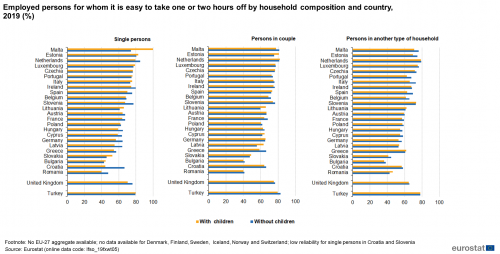
More flexibility to take days of leave at short notice for employed persons usually working at home
In the majority of Member States, employed persons who usually work at home were more flexible in terms of hours and days off than those who work at home on a less regular basis, i.e. sometimes to never. Examples of countries where this is highly visible are Hungary, Czechia and Latvia. In these countries, around nine in ten employed persons who usually work at home could easily take one or two days off at short notice (94.8 %, 91.6 % and 86.8 % respectively) while the shares were still relatively high but much lower for those never working at home (59.7 %, 74.5 % and 45.4 % respectively).
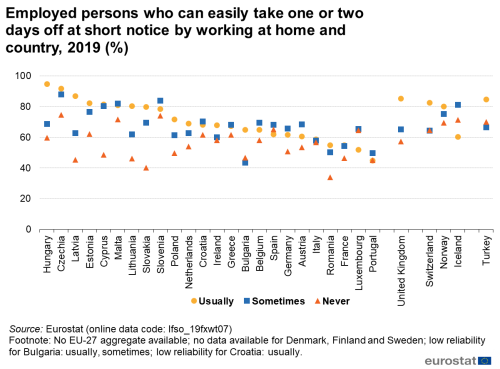
Majority rarely adapt working time because of unforeseen demands at work
In 2019, almost 60 % of the EU-27 workers rarely or never faced unforeseen demands, i.e. requirement by tasks, clients or superiors, with the consequence of changing working time in their main job (59.7 %). Around one in five employed persons was in this situation at least once a week (20.9 %) or once a month (19.4 %). At country level, one in three Luxembourgian workers changed working time due to unforeseen demands at least once a week, in comparison with only 8.1 % of workers in Bulgaria. Figures for employed persons who rarely or never adapted their working time in order to fulfill work-related tasks, have the reverse (i.e. complementary) conclusion for the aforementioned countries: Bulgaria has the highest share of those who rarely or never adapted working time (79.7 %) while Luxembourg has the lowest share (37.6 %). On the other hand, 29.0 % of Finnish employed persons faced unforeseen demands at least once a month versus only 10.1 % of their Spanish counterparts.
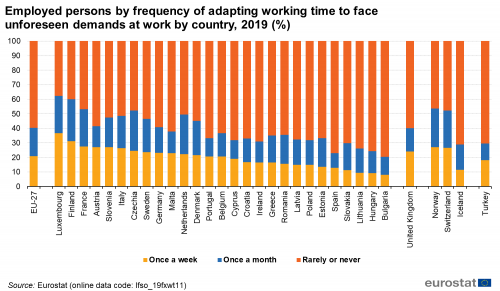
Workers with high educational attainment level often adapt their working time due to unforeseen demands
Which population groups register the highest shares of people adapting their working time due to unforeseen demands at work? In 2019, men were confronted more often than women with unforeseen demands occurring at least once a week: 23.6 % of men in comparison with 17.7 % of women. By contrast, there were no big differences between age groups: in all age groups around one in five people faced unforeseen demands at least once a week or once a month. However, differences can be found as regards the educational attainment level: one in four workers who attained a high education level changed their working time at least once a week to fulfill work-related tasks (25.5 %), compared with 16.3 % of those with a low educational attainment level and 19.1 % with a medium level. Self-employed persons with employees correspond to the group with the highest share of people adapting their working time to face unforeseen demands: almost half of them (47.4 %) did it on a weekly basis. The corresponding share is 37.0 % for self-employed persons without employees and 17.6 % for employees.
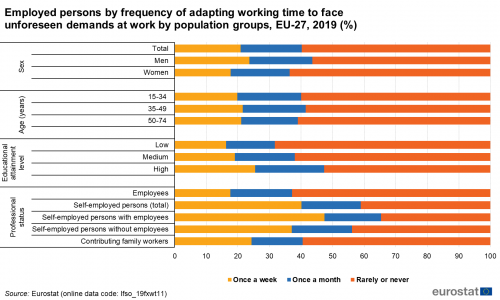
In Luxembourg, people employed in large-sized firms adapt their working time more often
In 2019, at EU-27 level, the size of the firm in which people are employed did not really affect the share of people adapting their work schedule at least once a week in order to fulfill work-related tasks. However, differences are visible at country level. Luxembourg employees in large-sized firms are the most likely to adapt their work schedule once a week: 39.3 % of them did this. In comparison, 29.2 % of Luxembourg employees in small-sized and 31.2 % in medium-sized firms did this. Bulgaria is at the other end of the scale with only 3.6 % of people working in large-sized firms, 5.0 % in medium-sized firms and 8.0 % in small-sized firms mentioning that they have adapted their working time at least once a week.
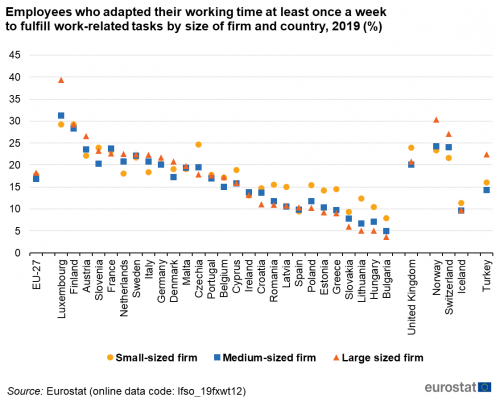
One in ten workers was contacted several times during leisure time with direct action required
In 2019, 17.2 % of workers were contacted several times during their leisure time (i.e. outside regular working hours) by their employer or their clients in the two months before the interview. More precisely, 10.1 % of workers were contacted several times with direct (i.e. before the next working day) action required, while 7.1 % were contacted without direct action required. The largest share of employed persons in the 27 Member States were never contacted during their leisure time in the two months before the interview (59.4 %). In comparison, 23.4 % of workers said that it occasionally happened.
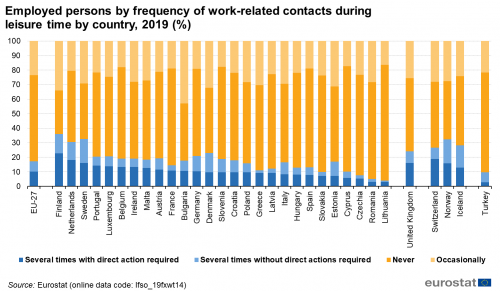
Finland had the largest share of employed persons who were contacted several times during leisure time and had to undertake action before the next working day (22.7 %). By contrast, the corresponding share for both Romania and Lithuania is 3.1 %. Lithuania recorded by far the highest share of people who were never contacted during their leisure time (79.6 %).
Self-employed persons with employees disturbed during leisure time more often than other groups
In 2019, relatively more women than men were never contacted by their employer, organisation or clients during their leisure time (in the last two months before the interview): 63.3 % of women against 56.1 % of men. By contrast, relatively more men than women were contacted several times with direct action required: 11.9 % of men versus 8.0 % of women. As regards the age groups, 11.2 % of people aged 35-49 were contacted several times with the request to respond before the next working day, against 8.2 % of those aged 15-34 and 10.4 % of those aged 50-74. In addition, the higher the educational attainment level, the higher the demand at work during leisure time: 14.3 % of workers who attained a high education level were approached during their leisure time and had to reply before the next working day, compared with only 5.9 % of those who attained a low education level and 8.5 % who attained a medium level.

More flexibility during leisure time was requested for self-employed persons than for employees or contributing family workers. Around one in four self-employed persons (24.1 %) was contacted during their leisure time with direct action required, compared with less than one in ten employees (7.8 %) or family workers (6.7 %). Self-employed persons with employees (32.1 %) were disturbed more often than self-employed persons without employees (20.7 %).
Men contacted more often than women for all economic activities and occupations
For all economic activities, relatively more men than women were contacted by their employer, organisation or clients during their leisure time with direct action required (in the last two months before the interview). The widest gap between men and women can be found in the financial and insurance activities (14.7 % of men versus 6.6 % of women), real estate activities (21.3 % versus 15.1 %) and professional, scientific and technical activities (16.7 versus 10.7 %).

Similar results can be found when focusing on the different types of occupations. The largest gap between men and women exist for managers: 30.3 % of male managers have been contacted during their leisure time to take direct action, compared with 22.4 % of female managers. By contrast, the smallest gender gaps were observed for the workers in elementary occupations (3.4 % of men versus 2.7 % of women) and for the clerical support workers (6.4 % of men versus 4.1 % of women).”
Source data for tables and graphs
Data sources
Source: The European Union Labour Force Survey (EU-LFS) is the largest European household sample survey providing quarterly and annual results on labour participation of people aged 15 and over as well as on persons outside the labour force. It covers residents in private households. Conscripts in military or community service are not included in the results. The EU-LFS is based on the same target populations and uses the same definitions in all countries, which means that the results are comparable between the countries. The EU-LFS is an important source of information about the situation and trends in the national and EU labour markets. Each quarter around 1.8 million interviews are conducted throughout the participating countries to obtain statistical information for some 100 variables. Due to the diversity of information and the large sample size, the EU-LFS is also an important source for other European statistics like Education statistics or Regional statistics.
Reference period and coverage: Results are obtained during the whole year (annually or quarterly). More detailed information can be found in the assessment report.
Target population: the target population of this ad hoc module is made of people in employment aged 15 years and older.
European aggregates: EU and EU-27 refer to the totality of the 27 EU Member States. If data is unavailable for a country, the calculation of the corresponding aggregates takes into account the data for the same country for the most recent period available. Such cases are indicated.
Definition of employment: The concepts and definitions used in the survey follow the guidelines of the International Labour Organisation. Employment covers persons aged 15 years and over (16 and over in Spain, Italy and the United Kingdom, 15-74 years in Denmark, Estonia, Latvia, Hungary, Finland, Sweden and Norway, and 16-74 years in Iceland), living in private households, who during the reference week performed work, even for just one hour, for pay, profit or family gain, or were not at work but had a job or business from which they were temporarily absent, for example because of illness, holidays, industrial dispute or education and training.
Educational attainment level: The level of educational attainment refers to the highest level of education successfully completed. A low level of educational attainment refers to ISCED levels 0-2 (less than primary, primary and lower secondary education), a medium level refers to ISCED levels 3 and 4 (upper secondary and post-secondary non-tertiary education) and a high level refers to ISCED levels 5-8 (tertiary education).
Context
The EU has a longstanding commitment to support the principles on secure and adaptable employment, work-life balance and well adapted work environment. This is evidenced by the European employment strategy, the employment guidelines and the European Pillar of Social Rights which express the need for greater adaptability of both enterprises and workers in Europe. Those EU initiatives highlight the need to collect data on the application of new practices in work organisation and working time arrangements and the experiences of workers with those practices and arrangements at European level. In order to monitor the progress in this area, the implementation of the European Union Labour Force Survey (EU-LFS) 2019 module on work organisation and working time arrangements is of high importance.
In the context of investigating the balance between work and family life of the European population, employment statistics are of high importance. Employment statistics are at the heart of many EU policies. The European employment strategy (EES) was launched at the Luxembourg jobs summit in November 1997 and was revamped in 2005 to align the EU’s employment strategy more closely to a set of revised Lisbon objectives, and in July 2008, employment policy guidelines for the period 2008–2010 were updated. In March 2010, the European Commission launched the Europe 2020 strategy for smart, sustainable and inclusive growth; this was formally adopted by the European Council in June 2010. The European Council agreed on five headline targets, the first being to raise the employment rate for women and men aged 20 to 64 years old to 75 % by 2020. EU Member States may set their own national targets in the light of these headline targets and draw up national reform programmes that include the actions they aim to undertake in order to implement the strategy.
The implementation of the strategy might be achieved, at least in part, through the promotion of flexible working conditions — for example, part-time work or work from home — which are thought to stimulate labour participation. Among others, initiatives that may encourage more people to enter the labour market include improvements in the availability of childcare facilities, providing more opportunities for lifelong learning, or facilitating job mobility. Central to this theme is the issue of ‘flexicurity’: policies that simultaneously address the flexibility of labour markets, work organisation and labour relations, while taking into account the reconciliation of work and private life, employment security and social protection. In line with the Europe 2020 strategy, the EES encourages measures to help meet three headline targets by 2020, namely, for:
• 75 % of people aged 20 to 64 to be in work;
• rates of early school leaving to be reduced below 10 %, and for at least 40 % of 30 to 34-year-olds to have completed tertiary education;
• at least 20 million fewer people to be in or at-risk-of-poverty and social exclusion.
Employment and social policies are also the main fields of interest of the European Pillar of Social Rights, which is about delivering new and more effective rights for citizens. It has three main categories: (1) Equal opportunities and access to the labour market; (2) Fair working conditions; (3) Social protection and inclusion.
In particular, today's more flexible working arrangements provide new job opportunities especially for the young but can potentially give rise to new precariousness and inequalities.
Direct access to
